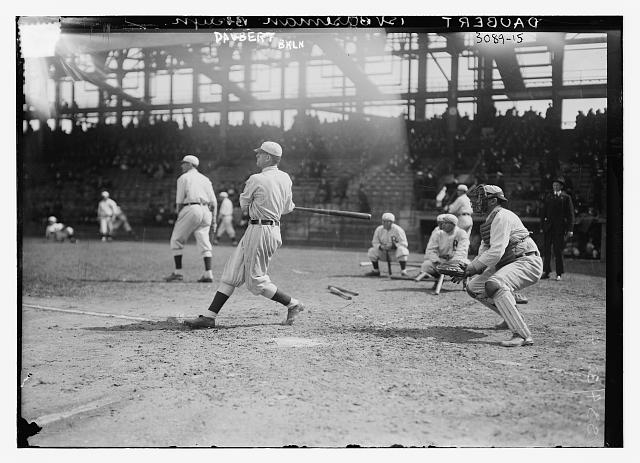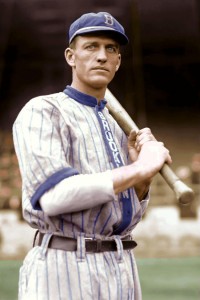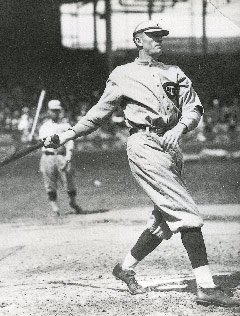Historical Hitter August 15 1914: Jake Daubert

 During a double header with the Brooklyn Superbas vs. the Phillies, Brooklyn’s first baseman came to the plate ten times and had six sacrifice hits – two in the first game and a record four in the nightcap. These boys from Brooklyn swept this late summer’s doubleheader with a combined score of 21 -9. In the game when he set the record four sacrifice hits, he was officially 0-1 and the only one not to score a run the blowout victory. Sources note that his ankle was injured and he could not run, so he became a bunting highlight reel. His name was Jake Daubert.
During a double header with the Brooklyn Superbas vs. the Phillies, Brooklyn’s first baseman came to the plate ten times and had six sacrifice hits – two in the first game and a record four in the nightcap. These boys from Brooklyn swept this late summer’s doubleheader with a combined score of 21 -9. In the game when he set the record four sacrifice hits, he was officially 0-1 and the only one not to score a run the blowout victory. Sources note that his ankle was injured and he could not run, so he became a bunting highlight reel. His name was Jake Daubert.
Daubert was known as a slick fielder and clutch hitter. And perhaps the greatest honest fielding National League first baseman in the decade of the 1910’s. 1913 was his finest season in which he won the Chamlers Award, the equivalent of the MVP award today. Even though he was second in career sacrifice hits, he was also a two time batting champ (1913 & 1914), and a two time triples leader (1918 & 1922). No doubt he had great bat control. In retrospect, SABR and STATS award him the gold glove at first base during the 1910’s decade for his noted defensive play.
Casey Stengel, a teammate in Brooklyn, was attributed in Sports of the Times by Arthur Daley, noted “Jake Daubert was as good a bunter as I ever saw.”
Jake in his own words described hitting as the ideal hand-eye coordination.
“A crack shot can hit a bird on the wing because the eye and his finger on the trigger act together. The amateur hunter can see the bird as well as the expert, but his finger on the trigger is perhaps a fraction of a second late. The good batter is like the good marksman. His wrists and his shoulders act with the eye.” – Jake Daubert

He played 15 years in the bigs, his first nine in Brooklyn and the remainder in the Queen City with the Reds. Tragically, did not finish the 24 season as he died in October 1924 from an undiagnosed genetic disorder known as hemolytic spherocytosis. His red blood cells were oval rather than circular which lead to spleen and Kidney issues. Now known as Minkowski-Chauffard disease, there is no cure.
Today the hitter of the day was one of finest from the deadball era. With the rise of Sabremetric analysis the art of the sacrifice hit is not part of the current game. Bill James noted in The New Bill James Historical Baseball Abstract, that Jake Daubert drove in 31 runs out of 100 hits, an abysmal ratio…” and ranks him 61 out of 100 at first.
He was a leader and popular player in the clubhouse and off the field as well. In fact, while he was in Brooklyn he was urged to run for one the Alderman spots in Brooklyn. Thankfully, he focused his leadership within baseball as he was a founding member of the Player’s Fraternity- the early predecessor of the Players Association (MLBPA). In the 1918 season which was cut short due to WWI and the Global Influenza Pandemic, the owners suspended the player’s salaries, Jake lead the lawsuit for the Player’s salaries being restored.
Here is the partial box score from Retrosheet.com showing Daubert’s record setting game:
Game Played on Saturday, August 15, 1914 (D) at Ebbets Field
| PHI N | 0 | 0 | 1 | 0 | 3 | 0 | 0 | 1 | – | 5 | 9 | 1 |
| BRO N | 2 | 1 | 0 | 2 | 1 | 1 | 2 | 4 | – | 13 | 18 | 4 |
Game 2
| Brooklyn Robins | AB | R | H | BB | SO | PO | A | |
| Dalton cf | 3 | 3 | 3 | 2 | 0 | 0 | 0 | |
| Daubert 1b | 1 | 0 | 0 | 0 | 0 | 6 | 1 | |
| Myers rf | 5 | 1 | 2 | 0 | 1 | 1 | 0 | |
| Wheat lf | 5 | 2 | 2 | 0 | 0 | 2 | 0 | |
| Egan ss | 4 | 1 | 3 | 0 | 0 | 3 | 2 | |
| Cutshaw 2b | 4 | 1 | 1 | 0 | 0 | 3 | 3 | |
| Getz 3b | 4 | 3 | 4 | 0 | 0 | 4 | 5 | |
| McCarty c | 4 | 1 | 2 | 0 | 0 | 5 | 0 | |
| Pfeffer p | 4 | 1 | 1 | 0 | 0 | 0 | 0 | |
| Totals | 34 | 13 | 18 | 2 | 1 | 24 | 11 |
FIELDING –
DP: 2. Getz-Cutshaw-Getz-Egan, Egan-Cutshaw.
E: Daubert (6), Egan 3 (19).
BATTING –
2B: Wheat (13); Egan (5); Getz (1); McCarty (12).
3B: Myers (4); Getz (1).
SH: Daubert 4 (27).
Team LOB: 3.
BASERUNNING –
SB: Wheat (15); Egan (6); Getz (1).

Sources:
http://diamondsanddugouts.blogspot.com/2012/04/jake-daubert.html
Retrosheet.com
Baseball-reference.com
Baseball-almanac.com
The New Bill James Historical Baseball Abstract, p 454
